
Tetris Worlds is a version of the video game Tetris. Originally released in 2001 for Microsoft Windows and Game Boy Advance, it was later released for Xbox, GameCube, and PlayStation 2 in 2002. In 2003, an Xbox Live version titled Tetris Worlds Online and a single-disc compilation version were released for the Xbox. The latter was bundled with Xbox systems.

Mr. Driller is a puzzle video game franchise created by Yasuhito Nagaoka and Hideo Yoshizawa for Namco. The eponymous first game was released in 1999 for arcades and several home consoles, such as the PlayStation. Gameplay in the series consists of controlling Susumu Hori, the titular Mr. Driller, or one of his friends and destroying colorful formations of blocks to make it to the bottom of a well. In order to survive, players need to collect air capsules to replenish their depleting oxygen and avoid being crushed by falling blocks.

Lumines: Puzzle Fusion is a 2004 puzzle game developed by Q Entertainment for the PlayStation Portable (PSP). During the game, players must strategically arrange falling 2×2 blocks comprising two colors to form single-color 2×2 squares. A vertical "time line" sweeps across the field, erases completed squares, and awards points. Each stage features a unique skin that influences the background, block colors, accompanying music, and the time line's speed.

Meteos is a 2005 tile-matching video game developed by Q Entertainment and published by Bandai for the Nintendo DS. It was produced by Q Entertainment founder Tetsuya Mizuguchi and designed by Masahiro Sakurai. Meteos was inspired by the video game Missile Command (1980), the film The Matrix (1999) and the television series 24 (2001-2010).

Resistance: Fall of Man is a 2006 first-person shooter video game for the PlayStation 3. It was developed by Insomniac Games and published by Sony Computer Entertainment. The game is set in an alternate history 1951, and follows Sergeant Nathan Hale as he and the human resistance forces attempt to drive a mysterious alien-like invasion out of the United Kingdom. The story continues in Resistance 2.
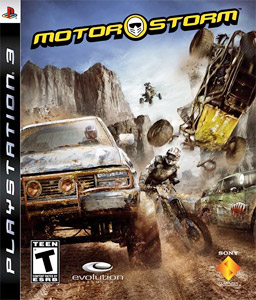
MotorStorm is a 2006 racing video game developed by Evolution Studios and published by Sony Computer Entertainment for the Sony PlayStation 3 computer entertainment system. Announced at E3 2005, the game was released in Japan on 14 December 2006 and worldwide in March 2007. MotorStorm has sold over 3 million units. Two sequels were made, MotorStorm: Pacific Rift in 2008, and MotorStorm: Apocalypse in 2011. Another game was also created, MotorStorm: Arctic Edge, for the PlayStation 2 and PlayStation Portable. As of January 2012, the online multiplayer servers for the game have been permanently shut down.

WWF SmackDown! 2: Know Your Role, known in Japan as Exciting Pro Wrestling 2, is a professional wrestling video game developed by Yuke's released in November 2000 on the PlayStation by THQ. It is the sequel to WWF SmackDown!, and the second game in the SmackDown series, itself based on the World Wrestling Federation professional wrestling promotion.

Kollon (ころん) is a 2003 Arcade puzzle game developed by MagicPot and published by CyberFront. Kollon was later ported to the PlayStation Portable as a launch title in 2004.
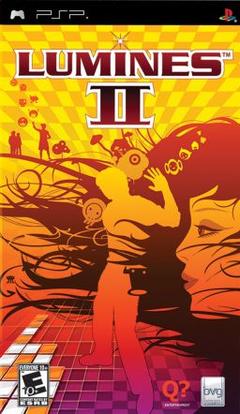
Lumines II is a 2006 puzzle video game developed by Q Entertainment for the PlayStation Portable (PSP). It was released in November 2006 in the PAL region and North America by Buena Vista Games, and in February 2007 in Japan by Bandai Namco Games. The objective of the game is to move and rotate 2×2 blocks to form colored squares of the same color. Points are awarded to the player when the Time Line erases the colored squares. It serves as a direct sequel to Lumines: Puzzle Fusion, expanding on previous modes from its predecessor and adding new modes such as Mission mode, Skin Edit mode, and Sequencer. Lumines II utilizes songs from its predecessor and introduces music videos as background skins from Japanese music artists and mainstream American music artists such as New Order, Missy Elliot, and Beck.
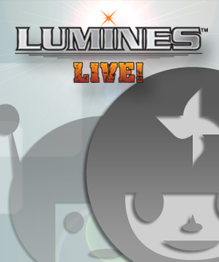
Lumines Live! is a 2006 puzzle video game developed by Q Entertainment for the Xbox 360. It was released worldwide in October 2006 and in Japan in March 2007. The objective of the game is to move and rotate 2×2 blocks to form colored squares of the same color. Points are awarded to the player when the Time Line erases the colored squares. Lumines Live! introduces online multiplayer, Xbox Live achievements, and a leaderboard.
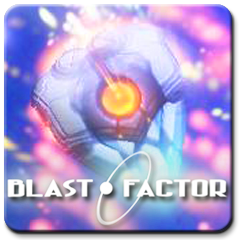
Blast Factor is a downloadable game developed by Bluepoint Games and published by Sony Computer Entertainment for the PlayStation 3, Notable for being the first game on the console running at a resolution of 1080p and a framerate of 60 alongside being one of its first digital-only games, it is the only game developed by Bluepoint Games that is not a remaster, remake or port.
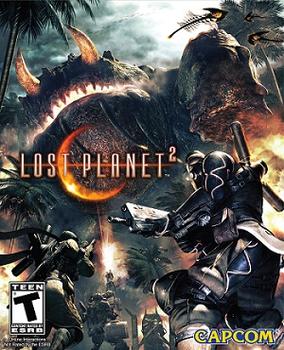
Lost Planet 2 is a third-person shooter video game developed and published by Capcom and Beeline Interactive, Inc. The game is the sequel to Lost Planet: Extreme Condition, taking place ten years after the events of the first game, on the same planet. The game was developed for BlackBerry, PlayStation 3, Xbox 360 and Microsoft Windows. Originally set to be released in early 2010, Capcom delayed the game's consoles release to May 11, 2010 in North America and Europe, May 13 in Australia and May 20 for Japan, while the BlackBerry version was released worldwide on April 28 and the Microsoft Windows version was released in October that year. The title sold more than 1.5 million copies worldwide.

Tetris Party is a puzzle video game by Hudson Soft for WiiWare. An installment of the Tetris series, the game supports the use of Miis and the Wii Balance Board, and features both local and online multiplayer in addition to several single-player modes unique to the game.

MotorStorm: Arctic Edge is the third game in the MotorStorm series of video games, developed by Bigbig Studios and published by Sony Computer Entertainment for the PlayStation Portable and PlayStation 2, which was released in 2009.
Katsumi Yokota is a Japanese video game designer and amateur musician who has contributed to the visual design and music of the Lumines series of games. He served as the art director of the original PSP game and as the director of Lumines Supernova for the PlayStation 3. Yokota created the original prototype of Lumines and composed three songs, which were later arranged for the album Lumines Remixes.

Resistance 3 is a 2011 science fiction post-apocalyptic first-person shooter developed by Insomniac Games and published by Sony Computer Entertainment for the PlayStation 3. Resistance 3 is the final installment in the Resistance trilogy. Resistance 3 is the first in the series to support 3D and PlayStation Move and was the first to introduce the PSN Pass program. The game shifts away from the military aspect of Resistance: Fall of Man and Resistance 2 and takes on a post-apocalyptic survival-horror feel.
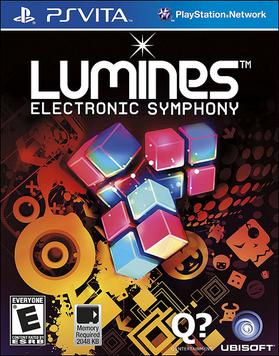
Lumines: Electronic Symphony is a game developed by Q Entertainment and published by Ubisoft for the PlayStation Vita.
Lumines is a puzzle video game series developed by Q Entertainment. The core objective of the games is to survive by rotating and aligning 2×2 blocks varying between two colors to form 2×2 squares of a single color which will be erased when the Time Line passes over them. The game is lost when the blocks reach the top of the playing field.

Lumines: Puzzle & Music is a puzzle game for iOS and Android, developed and published by Mobcast with Resonair as co-developer. It was the second smartphone game in the Lumines series after Lumines: Touch Fusion. The objective is to rotate and drop 2×2 blocks to create squares of the same color as a vertical line sweeps across the board to erase completed squares and award points to the player. It was soft launched in Japan, Australia, and New Zealand on July 19, 2016, before being fully released worldwide on September 1, 2016.

Mr. Driller is a 1999 puzzle arcade game developed and published by Namco. Versions for the PlayStation, Dreamcast, Microsoft Windows, Game Boy Color, WonderSwan Color, mobile phones, and iOS were also released. Controlling Susumu Hori, the titular "Mr. Driller", the player must dig their way to the bottom of the screen by destroying colored blocks that litter the playfield. Blocks will be cleared if four or more are touching each other, which can be used to cause chain reactions. Susumu has a constantly-depleting oxygen meter that can be refilled by collecting air capsules found throughout stages.



















